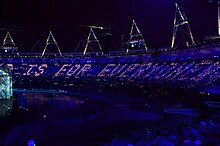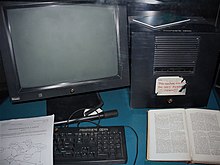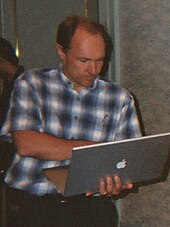 |
| SirTim Berners-Lee |
Today's Highlight in History
1990 – Tim Berners-Lee publishes a formal proposal for the World Wide Web.
Sir Timothy John "Tim" Berners-Lee, (born 8 June 1955), also known as "TimBL", is an English computer scientist, best known as the inventor of the World Wide Web. He made a proposal for an information management system in March 1989, and he implemented the first successful communication between a Hypertext Transfer Protocol (HTTP) client and server via the Internet sometime around mid November of that same year.Berners-Lee is the director of the World Wide Web
Consortium (W3C), which oversees the Web's continued development. He is also the founder of the World Wide Web Foundation, and is a senior researcher and holder of the Founders Chair at the MIT Computer Science and Artificial Intelligence Laboratory (CSAIL). He is a director of the Web Science Research Initiative (WSRI), and a member of the advisory board of the MIT Center for Collective Intelligence.
In 2004, Berners-Lee was knighted by Queen Elizabeth II for his pioneering work. In April 2009, he was elected a foreign associate of the United States National Academy of Sciences He was honoured as the "Inventor of the World Wide Web" during the 2012 Summer Olympics opening ceremony, in which he appeared in person, working with a vintage NeXT Computer at the London Olympic Stadium. He tweeted "This is for everyone", which instantly was spelled out in LCD lights attached to the chairs of the 80,000 people in the audience
Berners-Lee was born in southwest London, England, on 8 June 1955, one of four children born to Mary Lee Woods and Conway Berners-Lee. His parents worked on the first commercially-built computer, the Ferranti Mark 1. He attended Sheen Mount Primary School, and then went on to attend south west London's independent Emanuel School from 1969 to 1973. A keen trainspotter as a child, he learnt about electronics from tinkering with a model railway. He studied at The Queen's College of the University of Oxford from 1973 to 1976, where he received a first-class degree in physics
After graduation, Berners-Lee worked as an engineer at the telecommunications company Plessey in Poole. In 1978, he joined D. G. Nash in Ferndown, Dorset, where he helped create type-setting software for printers.
Berners-Lee worked as an independent contractor at CERN from June to December 1980. While there, he proposed a project based on the concept of hypertext, to facilitate sharing and updating information among researchers.To demonstrate, he built a prototype system named ENQUIRE.
After leaving CERN in late 1980, he went to work at John Poole's Image Computer Systems, Ltd, in Bournemouth, England. He ran the company's technical side for three years.The project he worked on was a "real-time remote procedure call" which gave him experience in computer networking. In 1984, he returned to CERN as a fellow.
In 1989, CERN was the largest Internet node in Europe, and Berners-Lee saw an opportunity to join hypertext with the Internet:
Berners-Lee wrote his initial proposal in March 1989, and in 1990, with the help of Robert Cailliau produced a revision which was accepted by his manager, Mike Sendall. He used similar ideas to those underlying the ENQUIRE system to create the World Wide Web, for which he designed and built the first Web browser. His software also functioned as an editor (called WorldWideWeb, running on the NeXTSTEP operating system), and the first Web server, CERN HTTPd (short for Hypertext Transfer Protocol daemon)
The World Wide Web (abbreviated as WWW or W3, commonly known as the Web) is a system of interlinked hypertext documents that are accessed via the Internet. With a web browser, one can view web pages that may contain text, images, videos, and other multimedia and navigate between them via hyperlinks.
In 1994, Berners-Lee founded the W3C at MIT. It comprised various companies that were willing to create standards and recommendations to improve the quality of the Web. Berners-Lee made his idea available freely, with no patent and no royalties due. The World Wide Web Consortium decided that its standards should be based on royalty-free technology, so that they could easily be adopted by anyone.
In 2001, Berners-Lee became a patron of the East Dorset Heritage Trust, having previously lived in Colehill in Wimborne, East Dorset, England.
In 2001 he became a Fellow of the Royal Society. He has been the recipient of several international awards including the Japan Prize, the Prince of Asturias Foundation Prize, the Millennium Technology Prize and Germany's Die Quadriga award. In 2004 he was knighted by H.M. Queen Elizabeth and in 2007 he was awarded the Order of Merit. In 2009 he was elected a foreign associate of the National Academy of Sciences. He is the author of "Weaving the Web".
On March 18 2013, Tim, along with Vinton Cerf, Robert Kahn, Louis Pouzin and Marc Andreesen, was awarded the Queen Elizabeth Prize for Engineering for "ground-breaking innovation in engineering that has been of global benefit to humanity."
 |
| Berners-Lee's tweet, "This is for everyone", at the 2012 Summer Olympic Games in London |
In 2004, Berners-Lee was knighted by Queen Elizabeth II for his pioneering work. In April 2009, he was elected a foreign associate of the United States National Academy of Sciences He was honoured as the "Inventor of the World Wide Web" during the 2012 Summer Olympics opening ceremony, in which he appeared in person, working with a vintage NeXT Computer at the London Olympic Stadium. He tweeted "This is for everyone", which instantly was spelled out in LCD lights attached to the chairs of the 80,000 people in the audience
Berners-Lee was born in southwest London, England, on 8 June 1955, one of four children born to Mary Lee Woods and Conway Berners-Lee. His parents worked on the first commercially-built computer, the Ferranti Mark 1. He attended Sheen Mount Primary School, and then went on to attend south west London's independent Emanuel School from 1969 to 1973. A keen trainspotter as a child, he learnt about electronics from tinkering with a model railway. He studied at The Queen's College of the University of Oxford from 1973 to 1976, where he received a first-class degree in physics
After graduation, Berners-Lee worked as an engineer at the telecommunications company Plessey in Poole. In 1978, he joined D. G. Nash in Ferndown, Dorset, where he helped create type-setting software for printers.
Berners-Lee worked as an independent contractor at CERN from June to December 1980. While there, he proposed a project based on the concept of hypertext, to facilitate sharing and updating information among researchers.To demonstrate, he built a prototype system named ENQUIRE.
 |
| The NeXT Computer used by Tim Berners-Lee at CERN |
After leaving CERN in late 1980, he went to work at John Poole's Image Computer Systems, Ltd, in Bournemouth, England. He ran the company's technical side for three years.The project he worked on was a "real-time remote procedure call" which gave him experience in computer networking. In 1984, he returned to CERN as a fellow.
In 1989, CERN was the largest Internet node in Europe, and Berners-Lee saw an opportunity to join hypertext with the Internet:
Berners-Lee wrote his initial proposal in March 1989, and in 1990, with the help of Robert Cailliau produced a revision which was accepted by his manager, Mike Sendall. He used similar ideas to those underlying the ENQUIRE system to create the World Wide Web, for which he designed and built the first Web browser. His software also functioned as an editor (called WorldWideWeb, running on the NeXTSTEP operating system), and the first Web server, CERN HTTPd (short for Hypertext Transfer Protocol daemon)
The World Wide Web (abbreviated as WWW or W3, commonly known as the Web) is a system of interlinked hypertext documents that are accessed via the Internet. With a web browser, one can view web pages that may contain text, images, videos, and other multimedia and navigate between them via hyperlinks.
 |
| Robert Cailliau, Jean-François Abramatic of IBM , and Tim Berners-Leeat the 10th anniversary of the World Wide Web Consortium. |
In 2001, Berners-Lee became a patron of the East Dorset Heritage Trust, having previously lived in Colehill in Wimborne, East Dorset, England.
In 2001 he became a Fellow of the Royal Society. He has been the recipient of several international awards including the Japan Prize, the Prince of Asturias Foundation Prize, the Millennium Technology Prize and Germany's Die Quadriga award. In 2004 he was knighted by H.M. Queen Elizabeth and in 2007 he was awarded the Order of Merit. In 2009 he was elected a foreign associate of the National Academy of Sciences. He is the author of "Weaving the Web".
On March 18 2013, Tim, along with Vinton Cerf, Robert Kahn, Louis Pouzin and Marc Andreesen, was awarded the Queen Elizabeth Prize for Engineering for "ground-breaking innovation in engineering that has been of global benefit to humanity."
 |
| Berners-Lee using his PowerBook |
In December 2004, he accepted a chair in Computer Science at the School of Electronics and Computer Science, University of Southampton, England, to work on the Semantic Web.
In a Times article in October 2009, Berners-Lee admitted that the initial pair of slashes ("//") in a web address were actually "unnecessary". He told the newspaper that he could easily have designed web addresses not to have the slashes. "There you go, it seemed like a good idea at the time," he said in his lighthearted apology
World Events
1905 – Norway holds a referendum in favor of monarchy over republic.
1912 – King George I of Greece makes a triumphal entry into Thessaloniki after its liberation from 482 years of Ottoman rule.
1912 – The frozen bodies of Robert Scott and his men are found on the Ross Ice Shelf in Antarctica.
1918 – Austria becomes a republic.
1920 – Italy and the Kingdom of Serbs, Croats and Slovenes sign the Treaty of Rapallo.
1945 – Sudirman is elected the first commander-in-chief of the Indonesian Armed Forces.
1956 – Morocco, Sudan and Tunisia join the United Nations.
1956 – In the midst of the Suez Crisis, Palestinian refugees are shot dead in the village of Rafah by Israeli soldiers following the invasion of the Gaza Strip.
1968 – Equatorial Guinea joins the United Nations
1975 – The Comoros joins the United Nations.
1978 – Pope John Paul II takes possession of his Cathedral Church, the Basilica of St. John Lateran, as the Bishop of Rome.
1979 – Iran hostage crisis: In response to the hostage situation in Tehran, US President Jimmy Carter orders a halt to all petroleum imports into the United States from Iran.
1980 – The NASA space probe Voyager I makes its closest approach to Saturn and takes the first images of its rings.
1990 – Crown Prince Akihito is formally installed as Emperor Akihito of Japan, becoming the 125th Japanese monarch.
1990 – Tim Berners-Lee publishes a formal proposal for the World Wide Web.
1991 – Santa Cruz massacre: Indonesian forces open fire on a crowd of student protesters in Dili, East Timor.
1993 – The first Ultimate Fighting Championship event, UFC 1, is held in Denver, Colorado.
1996 – A Saudi Arabian Airlines Boeing 747 and a Kazakh Ilyushin Il-76 cargo plane collide in mid-air near New Delhi, killing 349. The deadliest mid-air collision to date.
1997 – Ramzi Yousef is found guilty of masterminding the 1993 World Trade Center bombing.
1999 – The Düzce earthquake strikes Turkey with a magnitude of 7.2 on the Richter scale.
2001 – In New York City, American Airlines Flight 587, an Airbus A300 en route to the Dominican Republic, crashes minutes after takeoff from John F. Kennedy International Airport, killing all 260 on board and five on the ground.
2001 – Attack on Afghanistan: Taliban forces abandon Kabul, Afghanistan, ahead of advancing Afghan Northern Alliance troops.
2003 – Iraq War: In Nasiriyah, Iraq, at least 23 people, among them the first Italian casualties of the 2003 invasion of Iraq, are killed in a suicide bomb attack on an Italian police base.
2003 – Shanghai Transrapid sets a new world speed record (501 kilometres per hour (311 mph)) for commercial railway systems, which remains the fastest for unmodified commercial rail vehicles.
2011 – Silvio Berlusconi tenders his resignation as Prime Minister of Italy, effective November 16, due in large part to the European sovereign debt crisis.


No comments:
Post a Comment